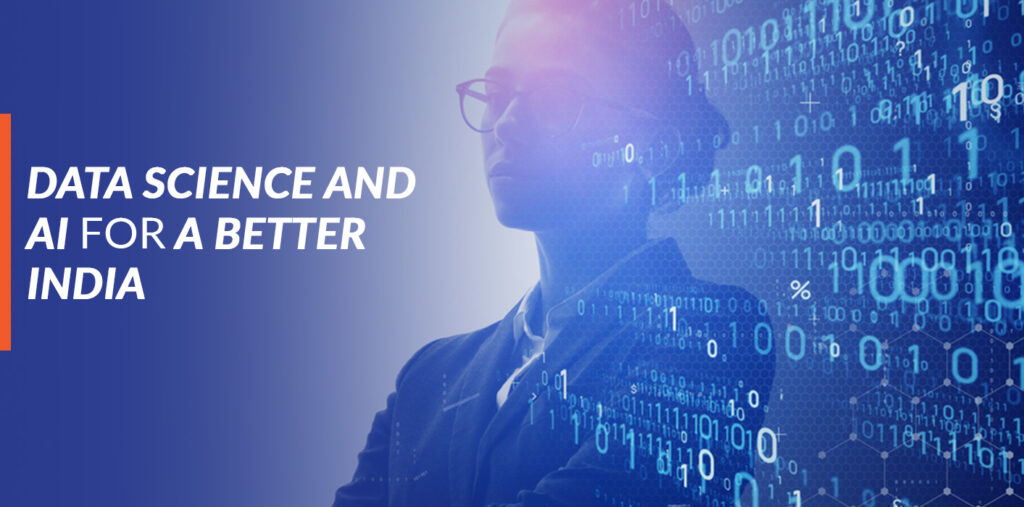A Glimpse into the Future
Artificial Intelligence (AI) and Data Science, the twin pillars of modern technology, have begun to reshape the very fabric of Indian society. As we venture into the uncharted territory of the future, the convergence of AI and Data science holds the promise of a digitally empowered India. This journey is going to be nothing short of an awe-inspiring narrative that bridges tradition and innovation, where millennia-old cultural heritage coexists with cutting-edge technology.
India, a land where tradition meets technology, has always been at the forefront of innovation. From the invention of zero in ancient mathematics to the rapid growth of the IT sector in the 21st century, India has a rich history of embracing change. Today, as we stand on the precipice of a new era, the fusion of Artificial Intelligence and Data Science is set to redefine the nation once more.
In this comprehensive exploration of the future of Data Science and AI in India, we’ll dive deep into the remarkable developments that are shaping the country’s technological landscape. From startup innovations to government initiatives, from the classroom to the battlefield, India’s journey into the age of AI is nothing short of extraordinary.
The Rise of Artificial Intelligence (AI) in India
Artificial Intelligence (AI) stands as the cornerstone of India’s technological revolution, acting as a potent catalyst for transformation in various sectors. Indian startups are pioneering this revolution with a fervour for innovation, deploying AI to optimize processes and enhance efficiency in industries like healthcare and agriculture. Supported by accelerators, incubators, and venture capitalists, these startups are driving groundbreaking solutions. Notably, Cure Metrix is revolutionizing mammography readings, ensuring more accurate breast cancer diagnoses, while Niramai is transforming early breast cancer detection with a non-invasive AI-driven approach. DeHaat is empowering farmers with data-driven insights for better crop management and increased yields, and Byju’s is personalising learning experiences for students, revolutionizing education.
Indian AI talent is gaining global recognition, contributing to the worldwide development of AI technology and shifting the narrative from ‘brain drain’ to ‘brain gain.’ Google’s AI lab in Bengaluru is at the forefront of AI research, collaborating with Indian institutions, while Indian researchers are increasingly publishing AI research papers in renowned conferences.
In summary, the combination of data science and AI is ushering in a new era of industry transformation in India, permeating every facet of the economy. E-commerce, the financial sector, and agriculture are experiencing remarkable shifts, propelled forward by the innovative use of these technologies. India stands on the edge of technological advancement and innovation, led by AI’s transformative power.
Government Initiatives and Investments in AI
The Indian government is actively fostering the growth of AI with strategic initiatives and investments, recognizing its potential to drive economic growth and societal development.
NITI Aayog’s AI Mission
NITI Aayog, the National Institution for Transforming India, is spearheading AI policy formulation, research, and development. It plays a crucial role in guiding the research and development segment about new and emerging technologies.
Key Initiatives
- Research Funding:NITI Aayog provides funding for AI research, enabling the development of cutting-edge solutions.
- Policy Framework: It is responsible for creating a comprehensive policy framework to promote AI in various sectors.
- Collaborations: NITI Aayog collaborates with industry, academia, and startups to drive AI innovation.
Financial Inclusion and Digital India
The Digital India mission aims to promote financial inclusion, supplement the education sector, and transform urban infrastructure. Several states, including Tamil Nadu, Punjab, Uttar Pradesh, and Telangana, are utilizing AI-based tools to support law and order, increase agricultural productivity, and improve healthcare delivery.
Real-World Applications
- Law and Order:AI-powered tools assist law enforcement agencies in crime prediction and prevention.
- Agriculture EnhancementAI supports farmers with data-driven recommendations for crop management and resource optimization.
- Healthcare Transformation: AI aidsin early disease detection, telemedicine, and healthcare accessibility, particularly in rural areas.
Agriculture Innovation
Agriculture is a cornerstone of the Indian economy, and AI is revolutionizing this sector. Initiatives and collaborations between the government and startups are driving innovation in agriculture.
Prominent Initiatives
- National Agriculture Market and eNAM: These electronic trading platforms are transforming India’s agricultural landscape by enabling transparent and efficient trade.
- Sustainable Agriculture: The National Sustainable Agriculture Mission seeks to increase agricultural output using sustainable technologies, including blockchain, machine learning, drones, and AI.
- Precision Agriculture: GPS-enabled devices and satellite imagery assist farmers in optimizing irrigation and fertilizer usage, resulting in improved crop quality and reduced environmental impact.
AI in Education and the Workforce
AI’s footprint in India extends beyond industries; it is deeply integrated into education and the workforce. These technologies are empowering learners and professionals to adapt to an ever-evolving world.
Personalized Learning
AI-driven adaptive learning platforms are reshaping education in India. These platforms use data and AI algorithms to create personalised learning paths for students, making education more engaging and effective.
Notable Developments
- AI in School Curriculum: The Central Board of Secondary Education (CBSE) introduced AI as a subject in Class IX and Class XI, aligning with the National Education Policy (NEP) 2020.
- Digital Learning Platforms: Open-source platforms like Diksha are leveraging AI for self-paced, digital education content, making learning accessible to students across states and union territories.
Impact on Education
As of March 2023, Diksha has 16.82 million students enrolled in various courses, with significant usage in states like Karnataka, Rajasthan, and Odisha. The concept of cloud-based education is gaining traction, improving access to education resources.
Reskilling and Upskilling
AI is reshaping the workforce in India, with a focus on reskilling and upskilling to meet the demands of the future job market. Emerging fields like AI ethics and AI project management are gaining prominence.
Workforce Evolution
- Online Courses: Professionals are increasingly turning to AI-powered online courses to acquire new skills and certifications.
- AI Job Growth: Experts predict a 31.4% increase in jobs related to data science and mathematical science, predominantly AI-based, by 2030.
- Automation and Augmentation: While concerns about job displacement exist, AI is also creating new avenues in emerging areas. Automation and augmentation are transforming how work is done, opening up opportunities for those who embrace these changes.
Impact on Industries
- Evolving Roles: Traditional job roles are evolving to incorporate AI, with new positions focused on AI ethics, data management, and AI project management.
- Economic Growth: AI-related job growth contributes to economic development and helps India maintain its position as a global IT and technology hub.
AI’s Role in Healthcare and Defence
In healthcare and defence, AI is playing a pivotal role, transforming these critical sectors and enhancing the nation’s capabilities.
Revolutionising Healthcare
AI is improving healthcare delivery in India across various dimensions, from diagnostics to patient care.
Key Developments
- Early Disease Diagnosis: AI-powered diagnostic tools aid in early disease detection, improving the chances of successful treatment.
- Drug Discovery: AI accelerates drug discovery by analysing vast datasets and predicting potential drug candidates.
- Telemedicine: AI enables remote consultations and diagnostics, particularly in underserved rural areas.
AI in Defence
India’s defence industry is harnessing AI to enhance the capabilities of the armed forces. AI is playing a crucial role in intelligence, surveillance, and reconnaissance (ISR), creating innovative solutions for data analysis, logistics, and autonomous weaponry.
Transforming Defence
- Intelligence and Reconnaissance: AI-powered systems provide rapid and accurate intelligence, enhancing national security and counter-terrorism efforts.
- Autonomous Weaponry: AI is enabling the development of autonomous weaponry, changing the nature of modern warfare.
Conclusion
The trajectory of AI and data science in India is nothing short of remarkable. From AI startups leading innovation to government initiatives supporting AI development, India’s journey into the AI era is both dynamic and exciting. As the nation continues to embrace AI, it will further propel industries, redefine education and workforce dynamics, and contribute significantly to healthcare, defence, and agriculture.
As we stand on the cusp of this technological revolution, India is poised to become a global AI powerhouse. While challenges persist, India’s resilience and adaptability ensure a future where tradition and technology coexist harmoniously, promising a brighter, more digitally empowered future. The story of data science and AI in India is a tale of innovation, opportunities, and boundless potential. It’s a story that’s only just begun, and the chapters to come are filled with promise.
With AI and data science as their guiding stars, the people of India are poised to navigate the vast sea of opportunity and technology, shaping a future that combines ancient wisdom with cutting-edge innovation. In the coming years, as AI continues to evolve, India will stand as a beacon of progress, showing the world how tradition and technology can not only coexist but thrive together, building a future that’s brighter, smarter, and more inclusive.








